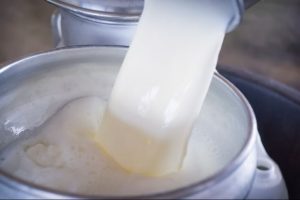
“So far, they seem pretty happy about it,” said Steamboat Springs School District Nutritional Services Director Max Huppert.
“They are consuming more milk than they were before, and choosing it over juice,” he said.
Last year, only skim flavored milk was allowed under federal USDA guidelines.
And guidelines dictate offering only 1% or skim white milk, Huppert said. 2% milk isn’t available to him as an ordering option, and certainly no whole milk. And no milk is not an option, either.
Part of the politics of milk in schools has to do with dairy industry lobbyists.
Milk consumption has seen a decline nationwide, and the industry has self-identified as being in crisis.
The change to allow 1% flavored milk, and legislation introduced to bring whole milk back to schools, came about following the appointment of Agriculture Secretary Sonny Perdue, who used to be in the dairy business.
Proponents argue the sugar in 1% flavored milk is worth the calcium benefit.
A January 2019 article in Bloomberg BusinessWeek stated: “The Department of Agriculture is throwing out Obama-era school nutrition standards and tossing a lifeline to the dairy industry. It’s called more fat, sugar and salts.”
Under the 2010 Healthy-Hunger-Free Kids act, nutrition standards began to require more fruits and vegetables, leaner proteins, calorie limits, more whole grains and lower sodium. And chocolate or strawberry milk had to be fat-free.
Perdue blamed the Obama-era guidelines for the industry decline, though other factors likely also play a role — including a growing preference for milk alternatives and demographics showing fewer kids in the population.
According to the Bloomberg article: “When the Obama-era rules took effect in 2012, requiring all flavored milk in schools to be skim, it only exacerbated the industry-wide slide. Skim doesn’t taste as good, and more kids passed. By the MilkPEP’s [Milk Processor Education Program] count, children caused the largest share of milk’s volume drop from 2011 to 2015.”
USDA data shows a gradual decline in milk consumption from 1980, with whole milk seeing the steepest decline.
In Huppert’s ten-year tenure, whole milk has never been an option, he said.
Huppert said the kids didn’t like the fat-free chocolate milk. It tasted weird, he said, possibly a fault in the formulation. The fat-free white milk wasn’t popular either. They are required to offer at least two varieties.
Of course, there is also a debate on whether or not milk, indeed, does a body good.
Milk is an easy and efficient way for kids to get some key nutrients, said Pediatrics of Steamboat Springs Pediatrician Dr. Ron Famiglietti — namely calcium and vitamin D.
But, there are other ways to get those nutrients, he notes. And Famiglietti supports those who choose routes on equal grounds to the milk drinkers.
Other dairy products like cheese and yogurt have calcium, as do vegetables and nuts. “Just not nearly as much,” he said.
Huppert notes cheese does not seem to breed the same controversy as milk.
In a Reader’s Digest article titled “Is Milk Good for You?,” data showed milk sales dropped significantly in Europe during the past decade. However, “While the consumption of liquid milk products has fallen, the consumption of cheese has increased rapidly, says Johanna Mäkelä, professor of food culture at the University of Helsinki. ‘So it could be said that milk is still consumed a lot, but the form and the products made out of it have changed.’”
Vitamin D is added to milk, with the reasoning dating back to 1900 and concerns about rickets (a childhood bone disorder) and calcium absorption. Kids weren’t getting as much sun (and thus vitamin D), but today, too much UV exposure isn’t recommended, Famiglietti said. And in winter, they often are covered up and/or not outside as much. Other foods rich in vitamin D, like beef liver or fatty fish, tend not to be as kid-friendly, he noted.
In terms of skim or 1% versus whole milk, Famiglietti recommends that decision be made in consideration of the individual child — and whether or not they need more calories.
Whole milk can be a great source of nutrition and calories for kids who are underweight, he said, whereas kids who are overweight may be served better by the lower fat varieties.
And there is such thing as too much milk, he said. Two to three cups per day through the end of puberty — while those bones are growing — is the recommended amount.
In terms of the Obama-era requirements, Huppert said he was going that route anyway. And making things from scratch made it easier to include whole grains and limit the amount of processed food. He follows many of those tenets regardless of regulation, aiming to offer healthy food that kids want to eat.
Today, there are numerous milk alternatives. There’s rice milk, almond milk, hemp milk, cashew milk, soy milk, oat milk and coconut milk. And they all have their plusses and minuses, Famiglietti said, in terms of nutritional value, calories and kid-friendly taste.
Cow’s milk is not recommended for children younger than one, he said, for a number of reasons related to iron absorption, digestibility and other concerns.
An internet search on whether cow’s milk is good or bad for you brings, as with any controversial food, research and claims on both sides.
According to PETA, milk is bad for you because it “robs bones of calcium,” increases the risk of prostate cancer, ovarian cancer, high cholesterol, obesity and acne.
They’ve launched the campaign slogan “If she’s not your mom, it’s not your milk.”
But research also shows milk contains valuable vitamins and minerals that aren’t found in other beverages, and has an ideal ratio of protein, fat and carbohydrates. Studies can be found that attribute milk to strengthening bones, reducing the risk of stroke, type 2 diabetes and several cancers.
Then there is the issue of lactose intolerance, which happens when someone’s intestines lack the enzyme lactase needed to digest lactose, the naturally occurring sugar in milk and other dairy products.
Even lactose intolerance has a political side. Milk, and the ability to tolerate lactose, has actually been used as a symbol of purity by white supremacists. Studies show people of Northern European descent are better at processing lactose.
Huppert is all for keeping kids healthy and finding the best research to support that mission, though he favors less government restrictions in general when it comes to his menu planning.
Milk is an easy way to get Vitamin D and calcium, Famiglietti said, which are essential nutrients for growing humans. But it’s not the only way.
The overall diet of a child is a better gauge of healthy eating, Huppert said. And he suspects the guidelines that rule milk are often more political than nutritional.
























